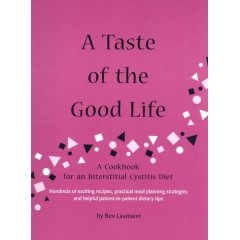New, IC Friendly, Sources of Vitamin C – Fresh Tastes by Bev
By Bev Laumann, Author of A Taste of The Good Life: A Cookbook for IC & OAB
Ever wonder if you’re getting enough vitamin C? It’s something that a lot of us think
about (or perhaps we should think about). Of course we can eat pears without suffering, but when it comes to vitamin C, pears just don’t measure up to such “high-C” fruits as oranges, guavas, or strawberries. So what bladder-friendly foods do have plenty of vitamin C? Although most people don’t realize it, broccoli and bell peppers are excellent sources of this important vitamin. In fact, according to the American Dietetic Association, a half-cup of raw red bell pepper has about 50% more vitamin C than a medium-sized fresh orange. Even cooked, a half-cup of broccoli boasts of just as much vitamin C as an orange.
A half-cup of raw red bell pepper has about 50% more vitamin C than a medium-sized fresh orange.
Several other vegetables also contain vitamin C in healthy doses. For instance, most adults can get all the daily vitamin C they need by eating about 2/3 of a cup of fresh green bell pepper, 1/3 cup of fresh red bell pepper, or 2/3 cup of cooked kohlrabi. Even a medium-sized baked potato has about 40 percent of the adult requirement of vitamin C (if you eat the skin).
Hearty homemade soups are one way to get vitamins from vegetables as well as
warm yourself up on a blustery, bone-chilling Winter day. Just remember not to overcook your soup and use a lid on the soup pot to retain as many vitamins as possible. Here is an easy-to-make soup from my cookbook, A Taste of the Good Life: A Cookbook for an Interstitial Cystitis Diet. Served with some crusty bread and a fresh pear, this soup makes a delicious and vitamin-packed meal.
Busy Day Chicken-Broccoli Soup
– serves 2
- 4 c. bladder-safe chicken broth (see note*)
- 3 cloves garlic, chopped
- 1/4 c. fresh carrots, peeled and chopped
- 3/4 c. cooked chicken, in bite-sized pieces
- 2 c. frozen broccoli florets
- 1/4 tsp. dried thyme
- 1/8 tsp. onion powder
- 1 bay leaf
- salt (and/or pepper) to taste
- 1/3 cup dry egg noodles
- Add all ingredients except noodles to a soup pot and bring to a simmer. Simmer about 12 minutes. Add noodles to the soup. Simmer a few minutes more, just until noodles are tender. Remove bay leaf before serving. This recipe also is delicious when using leftover turkey. Vitamin C: approx. 74 mg. per serving (about 120% of the adult RDA for vitamin C).
Notes: The key to making this recipe bladder-safe is the chicken broth. Be sure to use a brand that does not contain bladder provokers like monosodium glutamate (MSG), yeast extract, or hydrolyzed protein. Most chicken broth and chicken soups do contain some form of MSG. Either it is added in pure form (which means “monosodium glutamate” will be on the label), or it is contained in other ingredients in the broth (which means that though the bladder irritants are there, they won’t be listed on the label).
Health Valley makes an excellent canned, low-fat, MSG-free chicken broth that also has significantly less salt than most brands. The company is a division of Hain Celestial Group, whose products are marketed nationally. Many, many grocery chains carry Hain products so it may be relatively easy for your local store’s manager to special order the Health Valley chicken broth for you. Here is the company’s toll-free number, manned from 8:00 am to 4:00 pm Pacific time: 1-800-423-4846. You may be able to find out from them which stores near you carry Hain or Health Valley products. If you cannot locate a bladder-safe chicken broth, you can also make your own broth and freeze it.
Soup Toppers
Give any soup a festive look and boost its vitamin C by topping it with a couple
tablespoons of your favorite raw vegetable garnish. Any of these work well: alfalfa
sprouts; shredded carrot; finely chopped green, yellow, or red bell pepper; minced fresh parsley; chopped fresh broccoli florets; or finely shredded raw red cabbage.
References:
- Roberta Larson Duyff. The American Dietetic Association’s Complete Food and Nutrition Guide. 1998. Chronimed Publishing. Minneapolis, MN.
- USDA Nutrient Database for Standard Reference, release 12. Oct. 13, 1998. U.S. Department of Agriculture, Nutrient Data Laboratory.

